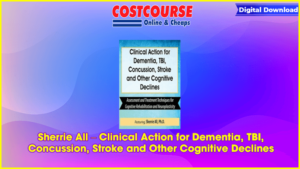Description
Neuroscience has given us incredible insights into the workings of the brain and its connection to our mental health. Recent research reveals that neuroplasticity takes place all through life, so you can offer hope for real change no matter how long your client has suffered.
Sherrie All – Neuroscience for Clinicians: Brain Change for Stress, Anxiety, Trauma, Moods and Substance Abuse
This recording will connect complicated science with your clinical practice, and transform how you view and work with traumatized, stressed, addicted, anxious and depressed clients!
Discover how and where neuroplasticity occurs, and ways to use it therapeutically. Participate in enjoyable learning experiences that provide you with the clear principles and background you need for utilizing neuroscience in your work. Draw on multiple modalities to overcome resistance, activate creative responses, and turn problems into potentials. Add new dimensions to each therapy session and initiate change using top-down, bottom-up, and horizontal methods that can be creatively individualized.
Finish this program feeling confident in bringing the latest findings from neuroscience into your treatments!
Handouts
Manual – Neuroscience for Clinicians (13.1 MB)
101 Pages
Available after Purchase
Outline
Tour through the Brain: What clinicians need to know from neurons to structures, to pathways, to networks
Feel your neurons activate
See brain structures in 3-D
Experience how the brain processes top-down, bottom-up, and horizontal
Actively engage your brain structures for change
Work with implicit and explicit memories
Learn how to rebalance key pathways with your interventions:
Pain Pathway
Reward Pathway
Fear-Stress Pathway
Nervous System Networks and the Social Brain: We are wired for attunement
Default Mode (DMN) and Task Mode Networks (TMN)
Healing attachment
Activate mirror neurons bottom-up
Neuroplasticity and Neurogenesis: How the brain can change
Three timeframes for change
Neuroplasticity at the synapse
How to foster neuroplasticity in clients
Neuroplasticity in action: Exercise your brain!
Practice the Interventions for Healing: Bottom-up, top-down, and horizontal
Sensory Awareness
Meditation and Mindfulness
Body Work
Unconscious and the DMN
Experience and activate the direct Mind-Body link
Integrate the Brain into Treatments
Stress
How stress alters the nervous system
Calm the stress/fear pathway
Develop alert/relaxed attention for better coping
Trauma
Develop security through self-soothing methods
Foster confidence with yoga body positioning
Extinguish traumatic memories
Reconsolidate implicit memories
Anxiety
The anxious brain reaction
Work top down/bottom up/horizontally
Calm the limbic system bottom up with movement
Soothe the insula through meditative sensory awareness
Deconstruct sensations mindfully
Balance the nervous system
Substance Abuse
Brain areas involved in addictions
Rewire the reward pathway
Detach form pleasure and pain
Activate the parietal lobes for sensory relaxation and enjoyment
Develop prefrontal connections for better judgment
Depression
The depressed brain pattern
Activate an under-activated nervous system with yoga postures and energy meditations
Regulate the limbic system by activating links to prefrontal cortex and cingulate gyrus with mindfulness turned outward
Practice the 4-step method to overcome negative self-suggestions
Unify real and ideal
Foster joyful relationship through mirror neurons
Develop compassion and gratitude
6 Principles for Incorporating the Brain into your Therapy








